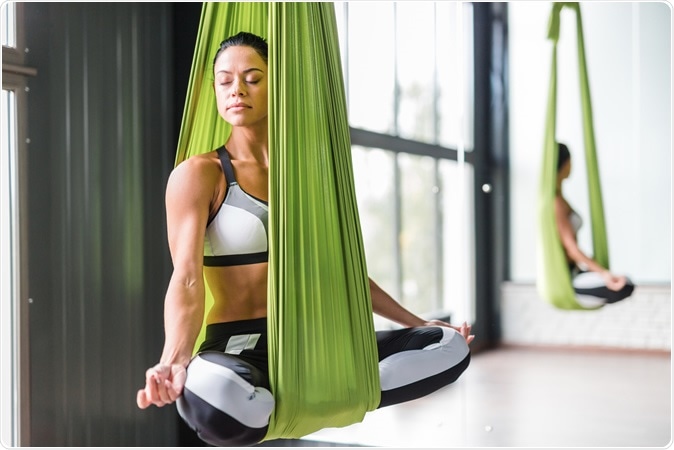Physical therapy has been recommended as part of treatment for low back pain for a very long time. Low back pain affects millions worldwide and may be short lasting or chronic or longer in duration for some individuals. Long term or intermittently occurring low back pain is referred as chronic low back pain.

Aerial yoga - Image Credit: Pressmaster / Shutterstock
Yoga is a form of physical therapy that involves practicing several physical poses, meditation and controlled breathing. There have been studies that have shown that yoga can actually help individuals with chronic low back pain. In 2013, Cramer and colleagues came up with an analysis of 10 different studies that looked at 967 patients in total who suffered from low back pain. Their study was published in Clinical Journal of Pain. The analysis showed that there was a strong indication that yoga benefitted these patients in the short term. There was moderately strong evidence of benefits for long-term effectiveness of yoga in chronic low back pain. The study then said that yoga could be part of the recommendations for additional physical therapy in chronic low back pain patients.
Coming to the latest study, researchers from Boston Medical Center, looked at the question if yoga could be comparable to physical therapy in treatment of chronic low back pain. For this study 320 adults with chronic low back pain were looked at. These participants were included from a university hospital and 7 community health centers. These centres typically cared for low-income group of patients and those from a varied racial background.
The 320 participants were divided randomly into three groups;
- One group had yoga classes every week for 3 months
- Another group had 15 visits with a physical therapist over 3 months
- The third group received educational booklets regarding back pain self-help and also relevant newsletters
At the end of three months, the group with yoga attended more yoga sessions or practiced at home for another 9 months. Similarly the physical therapy group met with the physical therapist every 2 months or did the taught exercises at home for 9 months more. The participants were given questionnaires that asked them about the levels of back pain and activity limitations they faced at the beginning of the study and at end of three months. Other parameters noted were use of pain medications that suggested lowered efficacy of the physical therapy, satisfaction expressed by participants to the treatment and quality of life after treatment.
Results showed that there were almost similar improvements in terms of pain and activity limitation over time with both yoga and physical therapy. At end of one year too, the improvements in these two groups remained. Pain medication usage was lower in both physical therapy group and yoga group at three months compared to the self-education group. Side effects of both yoga and physical therapy groups were mild joint and back pain.
Researchers concluded from the study that yoga could be a good alternative to physical therapy in treatment of chronic low back pain. These latest findings are published in Annals of Internal Medicine. The study was funded by National Center for Complementary and Integrative Health of the National Institutes of Health.